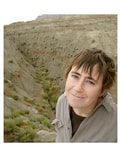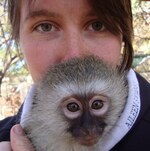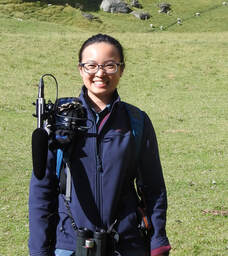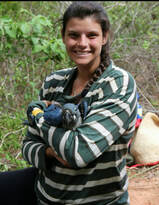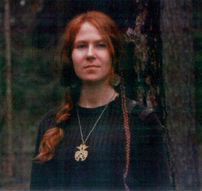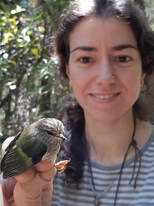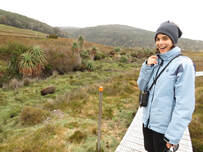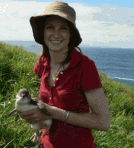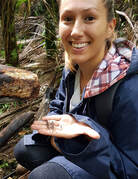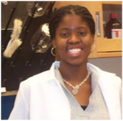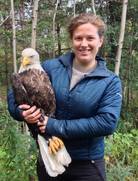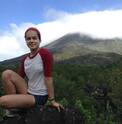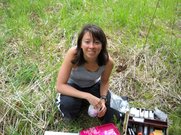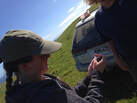The folks involved
The Circus Master:
|
I grew-up chasing critters in the deep woods and creeks of East Texas. I earned a BSc in Wildlife Biology from Texas A&M and then worked as a wildlife biologist for a time before returning to academia. I completed my PhD with Ellen Ketterson at Indiana University. Click here to see some excellent video footage of the junco. I then taught at University of Virginia's Mountain Lake Biological Station for the summer, The Field Biology of Sex and Sex Differences. Afterwards I moved to Australia to take-up a series of postdoctoral positions with a slew of great people including: Naomi Langmore, Andrew Cockburn, Sarah Pryke, Loeske Kruuk, Raoul Mulder, and Michelle Hall.
I am now a Senior Lecturer in Ecology, Evolution & Genetics at the University of Auckland. I have a great crew of researchers I'm working with on some wonderful and varied questions (see below). If you are interested in working together check out the NEWS & OPPORTUNITIES page. Click here to see my CV (usually very out of date). |
Postdoctoral associates
Sarah J Withers, PhD: Senior Research Fellow. Sarah has her fingers in many pies. But her main passions centre around the lovely titipounamu and trying to understand the colour green in bird plumage.
Current student collaborators
Current PhD candidates
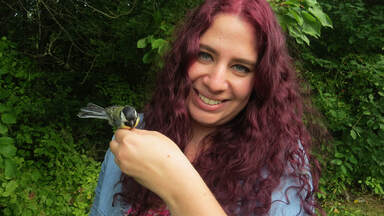
Juliane Gaviraghi Mussoi: MSc Animal Ecology, Lund University, Sweden
Juliane is a PhD candidate studying the effects of sleep on vocal performance of common mynas (Acridotheres tristis) and Australian magpies (Cracticus tibicen). Her study aims to investigate whether sleep disturbances as light and noise pollution affect when and how birds sing. Her MSc research focused on mirror-mediated spatial location and problem-solving in great tits (Parus major). Juliane has also previously worked with bird vision, parental care and feather colouration.
Juliane is a PhD candidate studying the effects of sleep on vocal performance of common mynas (Acridotheres tristis) and Australian magpies (Cracticus tibicen). Her study aims to investigate whether sleep disturbances as light and noise pollution affect when and how birds sing. Her MSc research focused on mirror-mediated spatial location and problem-solving in great tits (Parus major). Juliane has also previously worked with bird vision, parental care and feather colouration.
- Twitter: https://twitter.com/JGMussoi
- University profile: https://unidirectory.auckland.ac.nz/profile/jgav196
- Webpage: https://jgmussoi.wixsite.com/mysite
- E-mail: [email protected]
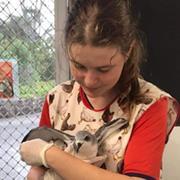
Ariel-Micaiah Heswall - Science Scholar and current PhD student studying seabird sensory ecology. She is looking at how seabirds perceive the threats of lights and plastics. I love volunteering and helping out in the community especially if it is related to birds/seabirds! She volunteers at BirdCare Aotearoa, a DOC permitted avian rehabilitation facility. She also volunteers with BirdsNZ on beach patrols and am regularly involved with BirdsNZ. behaviour.
Current MSc or Honours
Alisha Hart
Ana Menzies
Nisha Singh
Katie Vanderstock
Ana Menzies
Nisha Singh
Katie Vanderstock
Recently finished postgraduates
|
Aileen Sweeney: BSc (Hons) degree in Zoology, University College Cork in Ireland.
Aileen is a PhD student focusing on the costs of ornamentation, with a particular focus on female ornamentation and how it may, or may not, trade-off with cognitive ability. She is using pukeko as a model for these questions. In a former life she studied vervets monkeys and baboons.
|
|
Yen Yi Loo: MSc Bird Conservation, Manchester Metropolitan University (UK) .
Yen Yi is a PhD candidate working on an endemic New Zealand wren, the tītipounamu or rifleman (Acanthisitta chloris). Her study aims to document the vocal behaviour of this species by investigating the ontogeny, temporal changes and functions of their calls. Her study will contribute to understanding the evolutionary origins of vocal learning in the avian phylogenetic tree. Her MSc project explored the quality of citizen science data for studying continental scale migration patterns. She is passionate about connecting people with nature through the world of birds, sounds and data.
|
|
Maira Fessardi: BSc degree in Biological Sciences, University of Sao Paulo.
Maira is finishing her PGDipSci in Environmental Sciences and will be a Masters candidate in 2021. She'll be, studying the stress physiology of the New Zealand endemic seabird Grey-Faced Petrel (Pterodroma macroptera). The project aims to investigate the use of variation in population stress hormone levels as a proxy for ocean conditions and the use of feather corticosterone (CORT) as a conservation tool. She's passionate about nature and wildlife, having worked at Auckland Zoo as a bird keeper and Auckland Council as an environmental research assistant.
|
|
Daria Erastova: MSc (Hon) St Petersburg University. - (Main supervisor Margaret Stanley).
Daria is a PhD candidate studying the influence of garden sugar feeders on tui behaviour and health, and whether feeders alter the contribution tui make to pollinating indigenous plants. Her work investigates whether sugar feeders transmit potential avian pathogens and if such a year-round practice can lead to changes in tui social structure, thus altering their pollination patterns.
|
|
Ines G. Moran: MSc Biology, University of Windsor
Ines G. Moran recently completed her PhD on bioacoustics, vocal ecology of birds and vocal networks. Her thesis investigated the evolution of vocal learning in birds, as well as dialects and vocal behaviours of kinship groups in the titipounamu/rifleman (Acanthisitta chloris) in New Zealand. Her MSc research focussed on the aggressive escalation interactions and seasonal vocal variation of Savannah Sparrows (Passer sandwichensis) in Canada. In her spare time, she likes to think about ideas to further explore the remarkable world of animal sounds.
|
Former postdocs & research associates
|
Maider Iglesias-Carrasco: PhD in the Departamento de Ecología Evolutiva, Museo Nacional de Ciencias Naturales (MNCN-CSIC), Madrid.
Maider worked with us on some cool questions on bird colouration. Check out the paper here Sex in the city: sexual selection and urban colonization in passerines We also did some fun work on feather hormones - but that is a longer story. Currently, she is in Canberra, at the ANU, working with Megan Head and Michael Jennions. To read Maider’s work and see what she has been publishing about, take a look at her Google scholar page. |
Longer ago.....
|
Catherine Young: Evolution, Ecology & Genetics, Australian National University, PhD candidate; University of New South Wales, B.S. Biology with Honours 2007.
Cat's dissertation is focused on understanding the proximate mechanisms and ultimate costs and fitness benefits of aggression in a highly colonial-nesting bird, the crimson finch, using a combination of field and laboratory experiments. She was looking at whether melanin and carotenoid based colour patches signal aggression, and how testosterone relates to these signal and behaviours. Cat became Dr. Young in 2017. |
|
Nicole Haerewa: BSCc degree in biological sciences, The University of Auckland (Main superviser Chrissie Painting)
Nicole was an MSc student whose research aims to determine potential drivers of weapon size variation across a geographic range. As a great species model, she is using the weapon (rostrum) in male giraffe weevils which was previously shown to decrease in length in a north to south gradient. The giraffe weevils are a unique, endemic species to New Zealand with many behavioural traits that make them a prime species to observe behaviours in the field and maintain in a laboratory for experiments. She will be researching whether weapon size variation is driven by alterations in sexual selection pressures or temperature. Rebecca Mcqueen
Mackenzie Vitosovich |
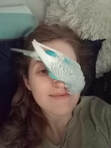
Jessica Peart completed a MSc on tītitipounamu (Acanthisitta chloris) plumage colouration. Her work aims to explore sexual dichromatism in titipounamu, exploring whether the need for crypsis or conspicuousness has been a greater driver of their plumage colouration.In her spare time, Jess is often found crouched in a bush somewhere botanizing, searching for fungi or taking photos of wildlife.
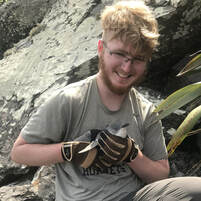
Spencer McIntyre: MSc (Dist.) Biodiversity & Conservation, Trinity College Dublin, Ireland - (Main superviser Brendon Dunphy)
Spencer was a PhD candidate working on seabird health in the Hauraki Gulf as an indicator of marine ecosystem function. His study aims to assess markers of physiological stress across a range of habitats in short ranging kororā/little penguins (Eudyptula minor), in comparison to more widely ranging kuaka/diving petrels (Pelecanoides urinatrix) and о̄i/grey faced petrels (Pterodroma macroptera gouldi). His MSc research focused on wetland habitat conservation using patchwork vegetation communities as indicators of localised impacts. Spencer is passionate about biodiversity conservation, and works closely with iwi, school groups, and other stakeholders in seabird population surveying and nature education.
Spencer was a PhD candidate working on seabird health in the Hauraki Gulf as an indicator of marine ecosystem function. His study aims to assess markers of physiological stress across a range of habitats in short ranging kororā/little penguins (Eudyptula minor), in comparison to more widely ranging kuaka/diving petrels (Pelecanoides urinatrix) and о̄i/grey faced petrels (Pterodroma macroptera gouldi). His MSc research focused on wetland habitat conservation using patchwork vegetation communities as indicators of localised impacts. Spencer is passionate about biodiversity conservation, and works closely with iwi, school groups, and other stakeholders in seabird population surveying and nature education.
- Email: [email protected]
- Twitter: @intyrely_eco
- University profile: https://unidirectory.auckland.ac.nz/profile/smci822
- https://spemcintyre.wixsite.com/home
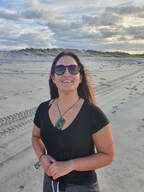
Melanie Hayden: PGDipSci in Marine Science, University of Auckland, New Zealand (Main Supervisor Dr. Brendon Dunphy).
Melanie is working towards her MSc in Biological Science, investigating the conservation physiology of Hōiho/Yellow-eyed penguins (Megadyptes antipodes). The project aims to investigate population stress hormone levels and nutritional quality as a proxy for environmental conditions both historically and contemporarily, using feather corticosterone (CORT) and stable isotope ratios as conservation tools. She is also investigating physiological dive limits in the Hōiho. Melanie is passionate about marine conservation and sustainable resource use.
Melanie is working towards her MSc in Biological Science, investigating the conservation physiology of Hōiho/Yellow-eyed penguins (Megadyptes antipodes). The project aims to investigate population stress hormone levels and nutritional quality as a proxy for environmental conditions both historically and contemporarily, using feather corticosterone (CORT) and stable isotope ratios as conservation tools. She is also investigating physiological dive limits in the Hōiho. Melanie is passionate about marine conservation and sustainable resource use.
Undergraduate and high school collaborators (alpha order)
|
Krystle Ainsworth: Morehouse School of Medicine, MS Public Health; Spelman 2009, B.S. Biology.
Krystle worked with me at Mountain Lake Biological Station as an REU (NSF's Research Experience for Undergraduates program) in 2008. Her project examined the relationship between developmental exposure to testosterone and adult maternal aggression in dark-eyed juncos. |
|
Kaitlin Alford: Bird Banding Technician, Hawk Ridge Bird Observatory; University of Virginia, B.A. Biology and Religious Studies.
I met Kaitlin when she was an REU at Mountain Lake Biological Station. She later joined my 2013/14 field crew in Australia assisting with a long-term project on superb fairy-wren and cuckoo co-evolution. She also worked with me on a project examining seasonal patterns in female fairy-wren song structure. |
|
Lauren Chaby: The Pennsylvania State University, Neuroscience & Ecology, PhD student; Clarkson University, B.S. Psychology & Biology.
Lauren was a REU at Mountain Lake Biological Station in 2009. Her project explored the relationships between risk-taking behavior and reproductive success in female dark-eyed juncos. Click here to see Lauren talk about her current research in a TedX conference talk. |
|
Jamie Corkill: BS Biology, University of Auckland. DOC Summer Scholarship student. Jamie is working on a collaborative project with the Department of Conservation assessing the effect of roads on native bird communities. She completed a summer project examining the factors that influence nest success in pīwakawaka/fantails.
|
|
Tamara Fetters: University of Virginia, PhD student; Virginia Tech, B.S. Biology.
Tamara was a REU at Mountain Lake Biological Station during the 2010 field season. Together we studied the role of preen oil in nest predation with a focus on contrasting preen oil from tree nesting to ground nesting birds. |
|
Michelle Forquer: Indiana University, B.S. Biology & Chemistry.
Michelle was an undergraduate research assistant from 2009-11. She assisted me in a project examining the links between testosterone in the yolk and nestling morphology. She also worked on a project quantifying inter-individual variation in female and male parental care. |
|
Meelyn Pandit, Field Technician at Cornell Lab of Ornithology; Indiana University, B.S. Biology.
Meelyn was an undergraduate research assistant in the Ketterson lab from 2010-13 working on a variety of projects. I also worked with Meelyn at Mountain Lake Biological Station. His project (supervised by Liz Carlton) examined the relationships between ornamentation and immune function in male dark-eyed juncos. |
|
Miriam Rich: Harvard University, History of Science, graduate student; Swarthmore College, B.A. in Biology.
Miriam was a REU at Mountain Lake Biological Station in 2009. Her project determined whether females exhibited a sex-specific response to simulated intruders. She is currently a PhD student focusing on the social and cultural history of medicine in the U.S., as it relates to gender and race. |
|
Rochelle Rodgers: BS Biology, University of Auckland. Rochelle was a summer scholarship student. Her project tested for behavioural evidence of brain lateralization in pukeko. In other words, are pukekos left/right handed? She's currently writing up her findings for publication and preparing to travel the world.
|
